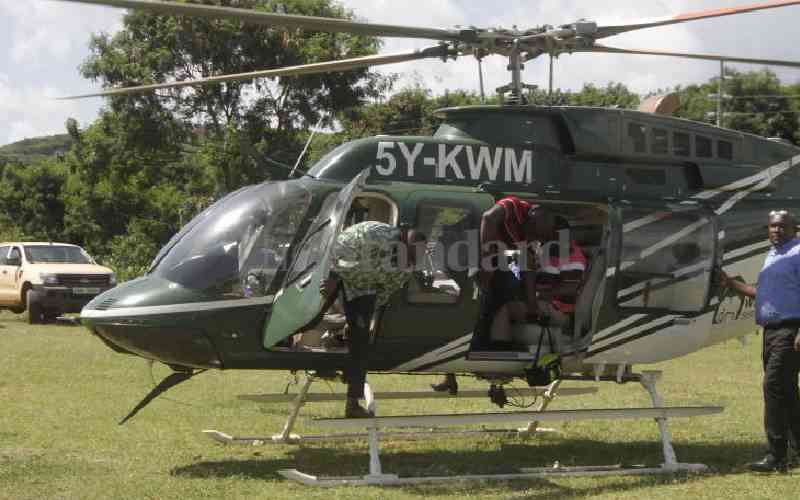 |
Kenya Aeronautical College boss Samson Muliro. [PHOTO: DAVID ODONGO/STA-
NDARD] |
By David Odongo
Lack of adequate engineers specialised in assembly and installation of new aircrafts has been identified as a major setback in the development of the local aviation industry.
The country has witnessed a boom in the aviation industry with influx of foreign airlines while existing ones continue to increase their fleets and open up new routes as passenger and freight volumes rise yet this has not grown in tandem with the required professionals in the crucial sector.
Globally, the boom has led to complex technologies and a steep increase in the rate of aircraft production, posing a strategic challenge to the industry.
Aeronautical Society of Kenya (ASK) says the country will only compete effectively in the global aviation industry if it has enough local-based aircraft manufacturing engineers. Kenya still over-relies on foreign engineers.
The shortfall is being blamed on lack of training opportunities in aeronautical engineering and the high cost of overseas training.
The local aviation industry, like the roads sector, is now embracing China where the cost of training an aeronautical engineer is cheaper than in the West.
Higher costs
It is estimated that it costs Sh2 million a year to train an aeronautical engineer in America and United Kingdom while in China it is about Sh250,000.
Having realised the dynamics, local colleges have started to look east. Kenya Aeronautical College (KAC) is among those, which have taken that step.
The college has partnered with Chinese Shenyang Aerospace University (SAU) to offer Bachelor degree in Aeronautical Engineering - manufacturing option.
KAC director Samson Muliro says the partnership is strategic and a first. “There is no university in East Africa that offers aeronautical engineering degree with a manufacturing option. It is high time we train our own engineers, and eventually start building aeroplanes. Others nations are doing it, why not us?” he poses.
The programme with SAU is offered for eighteen months.
“The students will then go to SAU in China to complete the degree programme,” says Muliro. He reveals that KAC has already sent the first batch of 20 students, all diploma holders, to pursue degree programmes at Shenyang university.
Qualified personnel
Stay informed. Subscribe to our newsletter
“The curriculum is approved by SAU senate and taught by the institution’s lecturers. The examinations are moderated, administered and processed by Shenyang senate,” explains Muliro.
The partnership between the two institutions will also see an exchange programme for students and lecturers.
Partnership
“The Shenyang university wanted to get a partner in Africa. Kenya being one of the most prominent countries in the continent, they approached Chinese embassy, which did independent studies amongst colleges. They finally settled on KAC,” says the engineer. Founded in 1952, SAU built its first airplane in 1959. The university is the only institution owned by the China Industry and Information Technology Ministry. Muliro says being the only university of aeronautical and astronautically engineering in Liaoning Province makes it a key partner.
Africa is facing a worsening shortage of aviation professionals with demand outstripping supply for skills needed to keep the commercial fleet flying safely.
Biting shortage
The shortage is greatest for aeronautical engineers, flight dispatchers, air cargo, dangerous goods personnel and aircraft information officers. Several colleges have now emerged locally and are struggling to meet the high demand.
Kenya Civil Aviation Authority Director General Hillary Kioko says the shortage needs to be addressed urgently. However, he points out that the mushrooming colleges might not solve the crisis, since most of them lack the necessary facilities and personnel.
Growing fast
“There is a general shortage of aviation professionals, not only in Kenya but worldwide. Here, the aviation industry is growing fast, yet some of our professionals have been finding greener pastures elsewhere, mostly in the Middle East. This has created a big problem,” says Kioko.
In Kenya, aircraft landings and take-offs increased from 195,000 in 2008 to 335,000 in 2010/2011, representing a 72 per cent increase. In the same period, the number of aircraft registered in the country increased from 757 to 1056. According to Sam Aketch, the secretary general of Aeronautical Society of Kenya, the country currently has a deficit of about 800 aviation professionals.
They include pilots and aeronautical engineers, air traffic controllers, aeronautical information officers, flight dispatchers, and air cargo personnel.
Competent staff
It is estimated that more than 33,500 new airplanes will be added over the next 20 years globally. Africa’s fleet is expected to grow by 800 aircraft.
“In the next few years, Africa will require 14,300 pilots and 19,200 technicians, yet we don’t have the capacity to train competent staff as fast as the industry dictates” says Aketch, who adds China comes as a blessing to local aviation industry.
 The Standard Group Plc is a
multi-media organization with investments in media platforms spanning newspaper
print operations, television, radio broadcasting, digital and online services. The
Standard Group is recognized as a leading multi-media house in Kenya with a key
influence in matters of national and international interest.
The Standard Group Plc is a
multi-media organization with investments in media platforms spanning newspaper
print operations, television, radio broadcasting, digital and online services. The
Standard Group is recognized as a leading multi-media house in Kenya with a key
influence in matters of national and international interest.
 The Standard Group Plc is a
multi-media organization with investments in media platforms spanning newspaper
print operations, television, radio broadcasting, digital and online services. The
Standard Group is recognized as a leading multi-media house in Kenya with a key
influence in matters of national and international interest.
The Standard Group Plc is a
multi-media organization with investments in media platforms spanning newspaper
print operations, television, radio broadcasting, digital and online services. The
Standard Group is recognized as a leading multi-media house in Kenya with a key
influence in matters of national and international interest.









